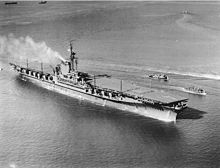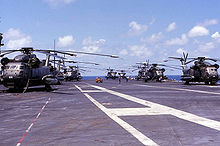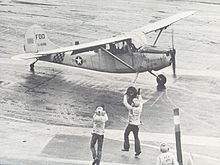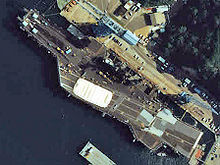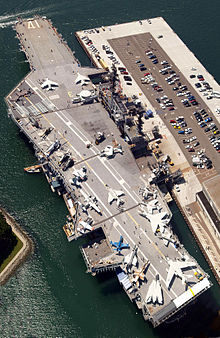- USS Midway (CV-41)
-
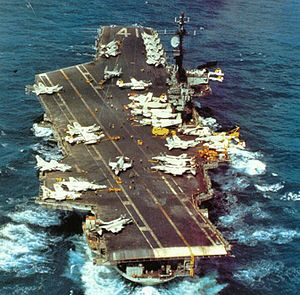
USS Midway (CVA-41), in the Western Pacific, 30 November 1974.Career (United States) 
Name: USS Midway Namesake: Battle of Midway Ordered: 1 August 1942 Builder: Newport News Shipbuilding Laid down: 27 October 1943 Launched: 20 March 1945 Commissioned: 10 September 1945 Decommissioned: 11 April 1992 Struck: 17 March 1997 Fate: museum ship General characteristics Class and type: Midway-class aircraft carrier Displacement: 45,000 tons at commissioning
74,000 tons at decommissioningLength: 972 ft (296 m) Beam: 113 ft (34.4 m)
136 ft (41.5 m); 238 ft (72.5 m) at flight deck after modernizationDraft: 34.5 ft (10.5 m) Propulsion: 12 boilers, four Westinghouse geared turbines[1] Speed: 33 knots (60 km/h) Complement: 4,104 officers and men Armament: At commissioning:
18 × 5"/54 caliber Mark 16 guns,
84 × Bofors 40 mm guns,
68 × Oerlikon 20 mm cannons
At decommissioning:
2 8-cell Sea Sparrow launchers,
2 Phalanx CIWSAircraft carried: 137 theoretical, 100 (WW2-Korea), 65 (Vietnam-retirement) USS Midway (CVB/CVA/CV-41) was an aircraft carrier of the United States Navy, the lead ship of her class, and the first to be commissioned after the end of World War II. Active in the Vietnam War and in Operation Desert Storm, she is currently a museum ship at the San Diego Aircraft Carrier Museum, in San Diego, California.
She is the only remaining US aircraft carrier of the World War II era that is not an Essex-class ship. When she was completed in 1945, she was the first US warship that was unable to utilize the Panama Canal due to her size.
Midway was laid down 27 October 1943 by Newport News Shipbuilding Co., Newport News, Virginia. Her revolutionary hull design was based on what would have been the Montana class battleships and gave her superior maneuverability over all previous carriers. She was launched 20 March 1945; sponsored by Mrs. Bradford William Ripley, Jr.; and commissioned 10 September 1945, Captain Joseph F. Bolger in command.
Early operations and deployment with the 6th Fleet
After shakedown in the Caribbean, Midway joined in the U.S. Atlantic Fleet training schedule, with Norfolk her homeport. From 20 February 1946 she was flagship for CarDiv 1. In March, she tested equipment and techniques for cold weather operations in the North Atlantic. East Coast and Caribbean training was highlighted by Operation Sandy in September 1947, in which she test fired a captured German V-2 rocket from her flight deck, the first such launching from a moving platform.
On 29 October 1947, Midway sailed for the first of her annual deployments with the 6th Fleet in the Mediterranean. A powerful extension of sea/air power, Midway trained between deployments and received alterations necessary to accommodate heavier aircraft as they were developed.
In June 1951, Midway operated in the Atlantic off the Virginia Capes during carrier suitability tests of the F9F-5 Panther. On 23 June, as Cdr. George Chamberlain Duncan attempted a landing in BuNo 125228, a downdraft just aft of the stern caused a ramp strike in which the forward fuselage broke away and rolled down the deck, pilot suffering burns. This footage has been used in several films including Men of the Fighting Lady, Midway, and The Hunt For Red October.[2]
In 1952, she participated in Operation Mainbrace, North Sea maneuvers with NATO forces, and on 1 October was redesignated CVA-41.
Midway cleared Norfolk 27 December 1954 for a world cruise, sailing via the Cape of Good Hope for Taiwan, where she joined the 7th Fleet for operations in the Western Pacific until 28 June 1955. During these operations, Midway pilots flew cover for the evacuation from the Quemoy-Matsu crisis [3] from the Tachen Islands of 15,000 Chinese nationalist troops and 20,000 Chinese civilians, along with their pigs, cows and chickens. On 28 June 1955 she sailed for overhaul at Puget Sound Naval Shipyard. Here, she was out of commission until 30 September 1957, while she underwent an extensive modernization program (SCB-110). Midway received an enclosed "hurricane bow," an aft deck-edge elevator, an angled flight deck, and steam catapults.
Home ported at Alameda, California, Midway began annual deployments with the 7th Fleet in 1958, and in the South China Sea during the Laotian Crisis of Spring 1961. During her 1962 deployment, her aircraft tested the air defense systems of Japan, Korea, Okinawa, the Philippines, and Taiwan. When she again sailed for the Far East 6 March 1965, her aircraft were prepared for combat operations, and from mid-April flew strikes against military and logistics installations in North and South Vietnam.
Returning to Alameda on 23 November, Midway entered San Francisco Bay Naval Shipyard on 11 February 1966 for a massive modernization (SCB-101.66) which proved to be very expensive and controversial. The flight deck was enlarged from 2.8 to 4 acres (11,300 to 16,200 m²). The elevators were enlarged, relocated, and given almost double the weight capacity. Midway also received new catapults, arresting gear, and a centralized air conditioning plant. Massive cost overruns raised the price of this program from $88 million to $202 million, and thus precluded a similar modernization planned for Franklin D. Roosevelt (CV-42). Midway finally recommissioned on 31 January 1970. It was also found that the modifications significantly reduced the ship's seakeeping capabilities and ability to conduct air operations in rough seas, which necessitated further modifications to correct the problem.
The first and last air-to-air kills in Vietnam
Illustrative of the major contribution the carrier made to the war was a notable "first" for aviators of her Attack Carrier Wing 2, who on June 17, 1965, downed the first four MiGs credited to U.S. Forces in Southeast Asia. On 12 January 1973, LT V. T. Kovaleski (pilot) and LT J. A. Wise (RIO) of the Midway's VF-161 Chargers downed a North Vietnamese MiG-17 with an AIM-9 Sidewinder launched from their F-4B Phantom II. This was the last air-to-air kill of the Vietnam War.
A return to Vietnam
Midway returned to Vietnam and on 18 May 1971, after relieving Hancock (CV-19) on Yankee Station, began single carrier operations which continued until the end of the month. She departed Yankee Station on 5 June, and completed her final line period on 31 October. She returned to her homeport on 6 November.
Midway, with embarked Carrier Air Wing 5 (CVW 5), again departed Alameda for operations off Vietnam on 10 April 1972. On 11 May, aircraft from Midway along with those from Coral Sea (CV-43), Kitty Hawk (CV-63), and Constellation (CV-64) continued laying minefields in ports of significance to the North Vietnamese—Thanh Hoa, Dong Hoi, Vinh, Hon Gai, Quang Khe and Cam Pha as well as other approaches to Haiphong. Ships that were in port in Haiphong had been advised that the mining would take place and that the mines would be armed 72 hours later. Midway continued Vietnam operations throughout the summer of 1972.
On 7 August 1972, an HC-7 Det 110 helicopter, flying from Midway, and aided by planes from the carrier and from Saratoga (CV-60), conducted a search and rescue mission for a downed aviator in North Vietnam. The pilot of an A-7 Corsair II aircraft from Saratoga had been downed by a surface-to-air missile about 20 miles (30 km) inland, northwest of Vinh, on 6 August. The HC-7 helo flew over mountainous terrain to rescue the pilot. The rescue helicopter used its search light to assist in locating the downed aviator and, despite receiving heavy ground fire, was successful in retrieving him and returning to an LPD off the coast. This was the deepest penetration of a rescue helicopter into North Vietnam since 1968. HC-7 Det 110 continued its rescue missions and by the end of 1972 had successfully accomplished 48 rescues, 35 of which were under combat conditions.
On 5 October 1973, Midway, with CVW 5, put into Yokosuka, Japan, marking the first forward-deployment of a complete carrier task group in a Japanese port, the result of an accord arrived at on 31 August 1972 between the U.S. and Japan. In addition to the morale factor of dependents housed along with the crew in a foreign port, the move had strategic significance because it facilitated continuous positioning of three carriers in the Far East at a time when the economic situation demanded the reduction of carriers in the fleet.
As a result of her service in Vietnam from April 30, 1972 to February 9, 1973, the USS MIDWAY (CVA-41) / ATTACK CARRIER AIR WING FIVE (CVW-5) was awarded a Presidential Unit Citation signed by Richard Nixon. The Presidential Unit Citation read as follows:
"By virtue of the authority vested in me as President of the United States and as Commander-in-Chief of the Armed Forces of the United States, I have today awarded
THE PRESIDENTIAL UNIT CITATION (NAVY) FOR EXTRAORDINARY HEROISM TO USS MIDWAY (CVA-41) and ATTACK CARRIER AIR WING FIVE (CVW-5)
For extraordinary heroism and outstanding performance of duty in action against enemy forces in Southeast Asia from 30 April 1972 to 9 February 1973. During this crucial period of the Vietnam conflict, USS MIDWAY and embarked Attack Carrier Air Wing FIVE carried out devastating aerial attacks against enemy installations, transportation, and lines of communications in the face of extremely heavy opposition including multi-calibre antiaircraft artillery fire and surface-to-air missiles. Displaying superb airmanship and unwavering courage, MIDWAY/CVW-5 pilots played a significant role in lifting the prolonged sieges at An Loc, Kontum, and Quang Tri and in carrying out the concentrated aerial strikes against the enemy's industrial heartland which eventually resulted in a cease-fire. By their excellent teamwork, dedication, and sustained superior performance, the officers and men of MIDWAY and Attack Carrier Air Wing FIVE reflected great credit upon themselves and upheld the highest traditions of the United States Naval Service." Signed Richard Nixon.
A copy of the PUC and a letter from the Department of the Navy, Office of the Chief of Naval Operations dated June 1, 2011 confirmed the above citations. Citation is available for review if needed.
Operation Frequent Wind, other deployments
Midway, Coral Sea (CV-43), Hancock (CV-19), Enterprise (CVN-65) and Okinawa (LPH-3) responded 19 April 1975 to the waters off South Vietnam when North Vietnam overran two-thirds of South Vietnam. Ten days later, Operation Frequent Wind was carried out by U.S. 7th Fleet forces. During this operation, Midway had off loaded fifty percent of her regular combat air wing at NS Subic Bay, Philippines. She steamed to Thailand and embarked 8 21st Special Operations Squadron CH-53 and 2 40th Aerospace Rescue and Recovery Squadron HH-53[4] helicopters for the purpose of ferrying people from Saigon out to the fleet cruising in the South China Sea. Hundreds of U.S. personnel and Vietnamese were evacuated to waiting ships after the fall of Saigon to the North Vietnamese.
On 29 April 1975, South Vietnamese Air Force Major Bung-Ly loaded his wife and five children into a two-seat Cessna O-1 Bird Dog and took off from Con Son Island. After evading enemy ground fire Major Bung-Ly headed out to sea and spotted the USS Midway. The Midway's crew attempted to contact the aircraft on emergency frequencies but the pilot continued to circle overhead with his landing lights turned on. When a spotter reported that there were at least four people in the two-place aircraft, all thoughts of forcing the pilot to ditch alongside were abandoned - it was unlikely the passengers of the overloaded Bird Dog could survive the ditching and safely egress before the plane sank. After three tries, Major Bung-Ly managed to drop a note from a low pass over the deck: "Can you move the helicopter to the other side, I can land on your runway, I can fly for one hour more, we have enough time to move. Please rescue me! Major Bung (Ly), wife and 5 child." Rear Admiral Larry Chambers (then Captain) ordered that the arresting wires be removed and that any helicopters that could not be safely and quickly be relocated should be pushed over the side. To get the job done he called for volunteers, and soon every available seaman was on deck, regardless of rank or duty, to provide the manpower to get the job done. $10 million (US currency) worth of UH-1 Huey helicopters were pushed overboard into the South China Sea. With a 500-foot ceiling, five miles visibility, light rain, and 15 knots of surface wind, Chambers ordered the Midway to make 25 knots into the wind. Warnings about the dangerous downdrafts created behind a steaming carrier were transmitted blind in both Vietnamese and English. To make matters worse, five additional UH-1s landed and cluttered up the deck. Without hesitation, Chambers ordered them scuttled as well. Captain Chambers recalled in an article in the Fall 1993 issue of the national Museum of Aviation History's "Foundation" magazine that "...the aircraft cleared the ramp and touched down on center line at the normal touchdown point. Had he been equipped with a tailhook he could have bagged a number 3 wire. He bounced once and came stop abeam of the island, amid a wildly cheering, arms-waving flight deck crew." Major Ly was escorted to the bridge where Captain Chambers congratulated him on his outstanding airmanship and his bravery in risking everything on a gamble beyond the point of no return without knowing for certain a carrier would be where he needed it. The crew of the Midway was so impressed that they established a fund to help him and his family get settled in the United States.[5] The Bird Dog that Major Bung-Ly landed is now on display at the Naval Aviation Museum in Pensacola, FL.[6]
Upon completion of ferrying people to other ships, she returned to Thailand and disembarked the Air Force helicopters. The CH-53s then airlifted over 50 South Vietnamese Air Force aircraft to the ship. With almost 100 helicopters and aircraft of the former South Vietnamese Air Force aboard, she steamed to Guam where the aircraft and helicopters were off loaded in twenty-four hours. On her way back to the Philippines to pick up her air wing she was rerouted to act as a floating airfield in support of special operation forces rescuing a pirated cargo ship (see Mayagüez incident). She picked up her regular air wing again a month later when she returned NAS Cubi Point, Philippines.
On 21 August 1976, a Navy task force headed by Midway made a show of force off the coast of Korea in response to an unprovoked attack on two U.S. Army officers who were killed by North Korean guards on 18 August. (The U.S. response to this incident was Operation Paul Bunyan). Midway's response was in support of a U.S. demonstration of military concern vis-à-vis North Korea.
Midway relieved Constellation as the Indian Ocean contingency carrier on 16 April 1979. Midway and her escort ships continued a significant American naval presence in the oil-producing region of the Arabian Sea and Persian Gulf. On 18 November, she arrived in the northern part of the Arabian Sea in connection with the continuing hostage crisis in Iran. Militant followers of the Ayatollah Khomeini, who had come to power following the overthrow of the Shah, seized the U.S. Embassy in Tehran on 4 November and held 63 U.S. citizens hostage. Midway was joined 21 November by Kitty Hawk (CV-63), and both carriers, along with their escort ships, were joined by the Nimitz (CVN-68) and her escorts on 22 January 1980. Midway was relieved by Coral Sea (CV-43) on 5 February.
Missions in the 1980s
Following a period in Yokosuka, Midway relieved Coral Sea 30 May 1980 on standby south of the Cheju-Do Islands in the Sea of Japan following the potential of civil unrest in the Republic of Korea. While transiting the passage between Palawan Island of the Philippines and the coast of Northern Borneo on July 29, Midway collided with the Panamanian merchant ship Cactus. The Cactus was 450 nautical miles (830 km) southwest of Subic Bay and headed to Singapore. The collision occurred near the liquid oxygen plant and two sailors working in the plant were killed and three were injured. Midway sustained light damage and three F-4 Phantom aircraft parked on the flight deck were also damaged.[7] On 17 August, Midway relieved Constellation to begin another Indian Ocean deployment and to complement the Dwight D. Eisenhower (CVN-69) task group still on contingency duty in the Arabian Sea. Midway spent a total of 118 days in the Indian Ocean during 1980.
On 16 March 1981, an A-6 Intruder from VA-115 aboard Midway sighted a downed civilian helicopter in the South China Sea. Midway immediately dispatched HC-1 Det 2 helicopters to the scene. All 17 people aboard the downed helicopter were rescued and brought aboard the carrier. The chartered civilian helicopter was also plucked out of the water and lifted to Midway's flight deck.
Midway continued serving in the western Pacific throughout the 1980s. In order to alleviate persistent seakeeping issues, Midway received hull blisters in 1986. The modification proved unsuccessful, and actually increased the vessel's instability in high seas.
On 25 March 1986, the final carrier launching of a Navy fleet F-4S Phantom II took place off Midway during flight operations in the East China Sea. The aircraft was manned by pilot Lt. Alan S. "Mullet" Colegrove and radar intercept officer Lt. Gregg "Ichabod" Blankenship of VF-151. Phantoms were being replaced by the new F/A-18 Hornets.
On 30 October 1989 an F/A-18 Hornet aircraft from the Midway mistakenly dropped a 500 pound general-purpose bomb on the deck of USS Reeves during training exercises in the Indian Ocean, creating a five-foot hole in the bow, sparking small fires, and injuring five sailors. Reeves was 32 miles (51 km) south of Diego Garcia at the time of the incident.[8]
Disaster struck the Midway on June 20, 1990. While conducting routine flight operations approximately 125 nautical miles northeast of Japan, the ship was badly damaged by two onboard explosions. These explosions led to a fire that raged more than ten hours. In addition to damage to the ship's hull, two crew members were killed and 9 others were wounded;[9] one of the injured later died of his injuries.[10] All 11 crewmen belonged to an elite fire-fighting team known as the Flying Squad. When Midway entered Yokosuka Harbor the next day, 12 Japanese media helicopters flew in circles and hovered about 150 feet above the flight deck. Three bus loads of reporters were waiting on the pier. About 30 minutes after Midway cast its first line, more than 100 international print and electronic journalists charged over the brow to cover the event. The news media made a major issue out of the incident, as it happened amid other military accidents. It was thought that the accident would lead to the ship's immediate retirement due to her age.
Operation Desert Storm and the 1990s
On 2 August 1990, Iraq invaded neighboring Kuwait and U.S. forces moved into Saudi Arabia as part of Operation Desert Shield to protect that country against invasion by Iraq. On 1 November 1990, Midway was again on station in the North Arabian Sea being the carrier of Battle Force Zulu (which included warships from the US, Australia, and other countries), relieving Independence. On 15 November, she participated in Operation Imminent Thunder, an eight-day combined amphibious landing exercise in northeastern Saudi Arabia which involved about 1,000 U.S. Marines, 16 warships, and more than 1,100 aircraft. Meanwhile, the United Nations set an ultimatum deadline of 15 January 1991 for Iraq to withdraw from Kuwait.
Operation Desert Storm began the next day, and the Navy launched 228 sorties from Midway and Ranger (CV-61) in the Persian Gulf, from Theodore Roosevelt (CVN-71) en route to the Gulf, and from John F. Kennedy, Saratoga, and America in the Red Sea. In addition, the Navy launched more than 100 Tomahawk missiles from nine ships in the Mediterranean Sea, the Red Sea, and the Persian Gulf. Desert Storm officially ended 27 February, and Midway departed the Persian Gulf on 11 March 1991 and returned to Yokosuka.
In June 1991, she left for her final deployment, this time to the Philippines to take part in Operation Fiery Vigil. Fiery Vigil, was the evacuation of 20,000 military members including their families from Clark AB, on the island of Luzon after the eruption of Mt. Pinatubo. The Midway, along with twenty other U.S. naval ships, ferried the evacuees to the island of Cebu, where they were taken off the ship by helicopter. After taking part in the evacuation, she once again, returned to Yokosuka.
A final cruise and then on to life as a museum
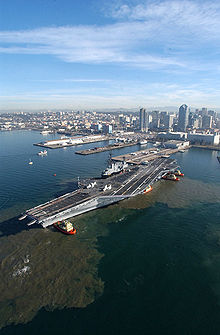 Midway prepares to moor at her final resting place at Navy pier in San Diego where she was to become the largest museum devoted to carriers and naval aviation. (10 January 2004)
Midway prepares to moor at her final resting place at Navy pier in San Diego where she was to become the largest museum devoted to carriers and naval aviation. (10 January 2004)
In August 1991, Midway departed Yokosuka and returned to Pearl Harbor. Here, she turned over with Independence which was replacing Midway as the forward-deployed carrier in Yokosuka. Midway then sailed to San Diego where she was decommissioned at Naval Air Station North Island on 11 April 1992 in a ceremony in which the main speaker was Secretary of Defense Dick Cheney. She was stricken from the Naval Vessel Register on 17 March 1997. During the decommissioning process, she was used to film portions of the movie At Sea, a documentary on carrier life shown only at the Navy Museum in Washington D.C. Both sailors and their families participated in the filming of the homecoming scenes.
On 30 September 2003, Midway began her journey from the Navy Inactive Ship Maintenance Facility, Bremerton, Washington, to San Diego, California in preparation for use as a museum and memorial. She was docked at the Charles P. Howard Terminal in Oakland, California, during the first week in October while the construction of her pier in San Diego was completed. Then, on 10 January 2004 the ship was moored at her final location at the Broadway Pier in downtown San Diego, where she was opened to the public on 7 June 2004. In the first year of operation, the museum doubled attendance projections by welcoming 879,281 guests aboard.
USS Midway Museum
Main article: USS Midway MuseumSince June 2004, the USS Midway has been in San Diego as the USS Midway Museum
See also
References
- ^ http://www.navysite.de/cvn/cv41.htm
- ^ Duncan's F9F. Check-six.com. Retrieved on 2010-11-25.
- ^ Historical Center Seeks Quemoy-Matsu Crisis Veterans
- ^ Tilford, Earl (1980). Search and Rescue in Southeast Asia 1961-1975. Office of Air Force History. p. 143. ISBN 9781410222640.
- ^ Shiel, Walt (1995). Cessna Warbirds, pp 119-120. Jones Publishing. ISBN 1-879825-25-2.
- ^ Watter, Steve. "Clear the Decks." Focus on the Family, 2004. Retrieved: 9 July 2008.
- ^ "The History of Midway's Magic". MidwaySailor.com. http://www.midwaysailor.com/midway/history.html. Retrieved 2008-02-19.
- ^ USS Reeves NavSea DC Museum - Accessed 16 June 2009
- ^ David Butts (1990-06-22). "Navy Recovers Bodies of Two Sailors Killed in Carrier Fire in Pacific". The Daily Gazette. http://news.google.ca/newspapers?id=GnMhAAAAIBAJ&sjid=tIgFAAAAIBAJ&pg=1026,5366997&dq=midway+carrier+fire&hl=en. Retrieved 2010-10-21.
- ^ "Midway Sailor Dies; death toll now 3". The Pittsburgh Press. 1990-06-30. http://news.google.com/newspapers?id=0kQgAAAAIBAJ&sjid=75YEAAAAIBAJ&pg=5115,7360893&dq=midway+carrier+fire&hl=en. Retrieved 2010-10-21.
- This article includes text from the public domain Dictionary of American Naval Fighting Ships.
Further reading
McGaugh, Scott Midway Magic - An Oral History of America's Legendary Aircraft Carrier, CDS Books, New York 2004, ISBN 1-59315-027-X
External links
- USS Midway Museum
- history.navy.mil: USS Midway
- MidwaySailor.com.
- HNSA Ship Page: USS Midway
- navsource.org: USS Midway (CV-41)
- A Podcast from Speaking of History about a tour of the USS Midway in July 2006Coordinates: 32°42′50″N 117°10′30″W / 32.713789°N 117.174940°W
Midway · Franklin D. Roosevelt · Coral Sea
Preceded by: Essex class · Followed by: Forrestal class
List of aircraft carriers of the United States NavyCategories:- Midway class aircraft carriers
- Ships built in Virginia
- 1945 ships
- World War II aircraft carriers of the United States
- Cold War aircraft carriers of the United States
- Vietnam War aircraft carriers of the United States
- Gulf War ships of the United States
- Museum ships in San Diego, California
- Visitor attractions in San Diego, California
- Landmarks in San Diego, California
- Aerospace museums in California
- Military and war museums in California
- Naval museums in the United States
- Museums established in 2004
Wikimedia Foundation. 2010.

